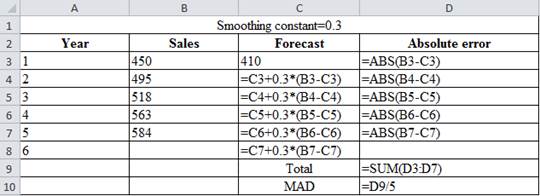
Concept explainers
To determine: Find the forecast of sales using exponential smoothing with smoothing constant 0.6 and 0.9 and infer the effect of exponential smoothing on forecast. Using MAD, determine the accurate forecast of exponential smoothing with given smoothing constant 0.3, 0.6 and 0.9.
Introduction: A sequence of data points in successive order is known as time series. Time series
Answer to Problem 17P
On Comparing MAD from exponential smoothing with smoothing constant 0.3, 0.6 and 0.9 (refer to equations (1), (2) and (3)), it can be inferred that the MAD of exponential smoothing with smoothing constant is most accurate because of least value of MAD.
Explanation of Solution
Forecast of sales using exponential smoothing with smoothing constant 0.6:
Given information:
| Year | Sales |
| 1 | 450 |
| 2 | 495 |
| 3 | 518 |
| 4 | 563 |
| 5 | 584 |
Formula to calculate the forecasted demand:
Where,
| Smoothing constant=0.6 | |||
| Year | Sales | Forecast | Absolute error |
| 1 | 450 | 410 | 40 |
| 2 | 495 | 434 | 61 |
| 3 | 518 | 470.6 | 47.4 |
| 4 | 563 | 499.04 | 63.96 |
| 5 | 584 | 537.416 | 46.584 |
| 6 | 565.3664 | ||
| Total | 258.944 | ||
| MAD | 51.7888 | ||
Excel worksheet:

Calculation of the forecast for year 2:
To calculate the forecast for year 2, substitute the value of forecast of year 1, smoothing constant and the difference of actual and forecasted demand in the above formula. The result of the forecast for year 2 is 434.
Calculation of the forecast for year 3:
To calculate the forecast for year 3, substitute the value of forecast of year 2, smoothing constant and the difference of actual and forecasted demand in the above formula. The result of the forecast for year 3 is 470.6.
Calculation of the forecast for year 4:
To calculate the forecast for year 4, substitute the value of forecast of year 3, smoothing constant and the difference of actual and forecasted demand in the above formula. The result of the forecast for year 4 is 499.04.
Calculation of the forecast for year 5:
To calculate the forecast for year 5, substitute the value of forecast of year 4, smoothing constant and the difference of actual and forecasted demand in the above formula. The result of the forecast for year 5 is 537.416.
Calculation of the forecast for year 6:
To calculate the forecast for year 5, substitute the value of forecast of year 5, smoothing constant and the difference of actual and forecasted demand in the above formula. The result of the forecast for year 6 is 565.36.
Calculation of MAD using exponential smoothing with smoothing constant α=0.6:
Formula to calculate the Mean Absolute Deviation:
Calculation of the absolute error for year 1:
The absolute error for year 1 is the modulus of the difference between 450 and 410, which corresponds to 40. Therefore, the absolute error for year 1 is 40.
Calculation of the absolute error for year 2:
The absolute error for year 2 is the modulus of the difference between 495 and 434, which is correspond to 61. Therefore, the absolute error for year 2 is 61.
Calculation of the absolute error for year 3:
The absolute error for year 3 is the modulus of the difference between 518and 470.6, which is correspond to 47.4. Therefore, the absolute error for year 3 is 47.4.
Calculation of the absolute error for year 4:
The absolute error for year 4 is the modulus of the difference between 563and499.04, which is correspond to 63.96. Therefore, the absolute error for year 4 is 63.96.
Calculation of the absolute error for year 5:
The absolute error for year 5 is the modulus of the difference between 584and537.416, which is correspond to 46.584. Therefore, the absolute error for year 5 is 46.584.
Calculation of the Mean Absolute Deviation using exponential smoothing with smoothing constant 0.6:
Upon the substitution of summation value of the absolute error for 5 years, that is, 258.944 is divided by the number of years. That is, 5 yields MAD of 51.7888.
The forecast of sales using exponential smoothing with 0.6 as smoothing constant is 565.36 and MAD is 51.7888.
Forecast of sales using exponential smoothing with smoothing constant 0.9:
Given information:
| Year | Sales |
| 1 | 450 |
| 2 | 495 |
| 3 | 518 |
| 4 | 563 |
| 5 | 584 |
Formula to calculate the forecasted demand:
Where,
| Smoothing constant=0.9 | |||
| Year | Sales | Forecast | Absolute error |
| 1 | 450 | 410 | 40 |
| 2 | 495 | 446 | 49 |
| 3 | 518 | 490.1 | 27.9 |
| 4 | 563 | 515.21 | 47.79 |
| 5 | 584 | 558.221 | 25.779 |
| 6 | 581.4221 | ||
| Total | 190.469 | ||
| MAD | 38.0938 | ||
Excel worksheet:

Calculation of the forecast for year 2:
To calculate the forecast for year 2, substitute the value of forecast of year 1, smoothing constant and difference of actual and forecasted demand in the above formula. The result of the forecast for year 2 is 446.
Calculation of the forecast for year 3:
To calculate the forecast for year 3, substitute the value of forecast of year 2, smoothing constant and difference of actual and forecasted demand in the above formula. The result of the forecast for year 3 is 490.1.
Calculation of the forecast for year 4:
To calculate the forecast for year 4, substitute the value of forecast of year 3, smoothing constant and difference of actual and forecasted demand in the above formula. The result of the forecast for year 4 is 515.21.
Calculation of the forecast for year 5:
To calculate the forecast for year 5, substitute the value of forecast of year 4, smoothing constant and difference of actual and forecasted demand in the above formula. The result of forecast for year 5 is 558.221.
Calculation of the forecast for year 6:
To calculate the forecast for year 6, substitute the value of forecast of year 5, smoothing constant and difference of actual and forecasted demand in the above formula. The result of forecast for year 6 is 581.42.
Calculation of MAD using exponential smoothing with smoothing constant α=0.9:
Formula to calculate the Mean Absolute Deviation:
Calculation of the absolute error for year 1:
The absolute error for year 1 is the modulus of the difference between 450 and 410, which corresponds to 40. Therefore, the absolute error for year 1 is 40.
Calculation of the absolute error for year 2:
The absolute error for year 2 is the modulus of the difference between 495 and 446, which corresponds to 49. Therefore, the absolute error for year 2 is 49.
Calculation of the absolute error for year 3:
The absolute error for year 3 is the modulus of the difference between 518and490.1, which corresponds to 27.9. Therefore, the absolute error for year 3 is 27.9.
Calculation of the absolute error for year 4:
The absolute error for year 4 is the modulus of the difference between 563and515.21, which corresponds to 4.254. Therefore, the absolute error for year 4 is 47.79.
Calculation of the absolute error for year 5:
The absolute error for year 5 is the modulus of the difference between 584and558.221, which corresponds to 25.779. Therefore, the absolute error for year 5 is 25.779.
Calculation of the Mean Absolute Deviation using exponential smoothing:
Upon the substitution of summation value of absolute error for 5 years, that is, 190.469 is divided by the number of years. That is, 5 yields MAD of 38.093.
The forecast of sales using exponential smoothing with 0.9 as smoothing constant is 581.4221 and MAD is 38.093.
Forecast of sales using exponential smoothing with smoothing constant 0.3:
Given information:
| Year | Sales |
| 1 | 450 |
| 2 | 495 |
| 3 | 518 |
| 4 | 563 |
| 5 | 584 |
Formula to calculate the forecasted demand:
Where,
| Smoothing constant=0.3 | |||
| Year | Sales | Forecast | Absolute error |
| 1 | 450 | 410 | 40 |
| 2 | 495 | 422 | 73 |
| 3 | 518 | 443.9 | 74.1 |
| 4 | 563 | 466.13 | 96.87 |
| 5 | 584 | 495.191 | 88.809 |
| 6 | 521.8337 | ||
| Total | 372.779 | ||
| MAD | 74.5558 | ||
Excel worksheet:

Calculation of the forecast for year 2:
To calculate the forecast for year 2, substitute the value of forecast of year 1, smoothing constant and difference of actual and forecasted demand in the above formula. The result of the forecast for year 2 is 422.
Calculation of the forecast for year 3:
To calculate the forecast for year 3, substitute the value of forecast of year 2, smoothing constant and difference of actual and forecasted demand in the above formula. The result of the forecast for year 3 is 443.9.
Calculation of the forecast for year 4:
To calculate the forecast for year 4, substitute the value of forecast of year 3, smoothing constant and difference of actual and forecasted demand in the above formula. The result of the forecast for year 4 is 466.13.
Calculation of the forecast for year 5:
To calculate the forecast for year 5, substitute the value of forecast of year 4, smoothing constant and difference of actual and forecasted demand in the above formula. The result of the forecast for year 5 is 495.191.
Calculation of the forecast for year 6:
To calculate the forecast for year 6, substitute the value of forecast of year 5, smoothing constant and difference of actual and forecasted demand in the above formula. The result of the forecast for year 6 is 521.833.
Calculation of MAD using exponential smoothing with smoothing constant α=0.3:
Formula to calculate the Mean Absolute Deviation:
Calculation of the absolute error for year 1:
The absolute error for year 1 is the modulus of the difference between 450 and 410, which corresponds to 40. Therefore, the absolute error for year 1 is 40.
Calculation of the absolute error for year 2:
The absolute error for year 2 is the modulus of the difference between 495 and 422, which corresponds to 73. Therefore, the absolute error for year 2 is 73.
Calculation of the absolute error for year 3:
The absolute error for year 3 is the modulus of the difference between 518 and 443.9, which corresponds to 74.1. Therefore, the absolute error for year 3 is 74.1.
Calculation of the absolute error for year 4:
The absolute error for year 4 is the modulus of the difference between 563 and 466.13, which corresponds to 96.87. Therefore, the absolute error for year 4 is 96.87.
Calculation of the absolute error for year 5:
The absolute error for year 5 is the modulus of the difference between 584 and 495.191, which corresponds to 88.809. Therefore, the absolute error for year 5 is 88.809.
Calculation of the Mean Absolute Deviation using exponential smoothing with 0.3 as smoothing constant:
Upon the substitution of summation value of absolute error for 5 years, that is, 372.779 are divided by the number of years. That is, 5 yields MAD of 74.5558.
The forecast of sales using exponential smoothing with 0.3 as smoothing constant is 521.833 and MAD is 74.5558.
Hence, on comparing MAD from exponential smoothing with smoothing constant 0.3, 0.6 and 0.9 (refer to equations (1), (2) and (3)), it can be inferred that MAD of exponential smoothing with smoothing constant is most accurate because of least MAD.
Want to see more full solutions like this?
Chapter 4 Solutions
PRIN.OF OPERATIONS MANAGEMENT-MYOMLAB
- Do you feel there is anything positive about rework?arrow_forwardDo you think technology can achieve faster setup times? How would it be implemented in the hospital workforce?arrow_forwardIn your experience or opinion, do you think process changes like organizing workspaces make a bigger difference, or is investing in technology usually the better solution for faster setups?arrow_forward
- Have you seen rework done in your business, and what was done to prevent that from occurring again?arrow_forwardResearch a company different than case studies examined and search the internet and find an example of a business that had to rework a process. How was the organization affected to rework a process in order to restore a good flow unit? Did rework hurt a process or improve the organization's operational efficiency? • Note: Include a reference with supportive citations in the discussion reply in your post.arrow_forwardSetup time is very important in affecting a process and the capacity of a process. How do you reduce setup time? Give examples of reducing setup time. Please Provide a referenecearrow_forward
- Do you think TPS was successful? If so, how? Are there other companies that have used TPS? If so, give examples. Please provide a referencearrow_forwardGiven the significant impact on finances, production timelines, and even equipment functionality, as you pointed out, what do you believe is the most effective single strategy a company can implement to significantly reduce the occurrence of rework within their operations?arrow_forwardDurban woman, Nombulelo Mkumla, took to social media last week to share how she discovered the rodent.In a lengthy Facebook post, she said she purchased the loaf of bread from a local shop after work on August 27.For the next days, Mkumla proceeded to use slices of bread from the load to make toast."Then, on the morning of August 31, I took the bread out of the fridge to make toast and noticed something disgusting andscary. I took a picture and sent it to my friends, and one of them said, 'Yi mpuku leyo tshomi' [That's a rat friend]“."I was in denial and suggested it might be something else, but the rat scenario made sense - it's possible the rat got into thebread at the factory, and no one noticed," Mkumla said.She went back to the shop she'd bought the bread from and was told to lay a complaint directly with the supplier.She sent an email with a video and photographs of the bread.Mkumla said she was later contacted by a man from Sasko who apologised for the incident.According to…arrow_forward
- PepsiCo South Africa says the incident where a woman discovered part of a rodent in her loaf of bread, is anisolated occurrence.Durban woman, Nombulelo Mkumla, took to social media last week to share how she discovered the rodent.In a lengthy Facebook post, she said she purchased the loaf of bread from a local shop after work on August 27.For the next days, Mkumla proceeded to use slices of bread from the load to make toast."Then, on the morning of August 31, I took the bread out of the fridge to make toast and noticed something disgusting andscary. I took a picture and sent it to my friends, and one of them said, 'Yi mpuku leyo tshomi' [That's a rat friend]“."I was in denial and suggested it might be something else, but the rat scenario made sense - it's possible the rat got into thebread at the factory, and no one noticed," Mkumla said.She went back to the shop she'd bought the bread from and was told to lay a complaint directly with the supplier.She sent an email with a video and…arrow_forwardDurban woman, Nombulelo Mkumla, took to social media last week to share how she discovered the rodent.In a lengthy Facebook post, she said she purchased the loaf of bread from a local shop after work on August 27.For the next days, Mkumla proceeded to use slices of bread from the load to make toast."Then, on the morning of August 31, I took the bread out of the fridge to make toast and noticed something disgusting andscary. I took a picture and sent it to my friends, and one of them said, 'Yi mpuku leyo tshomi' [That's a rat friend]“."I was in denial and suggested it might be something else, but the rat scenario made sense - it's possible the rat got into thebread at the factory, and no one noticed," Mkumla said.She went back to the shop she'd bought the bread from and was told to lay a complaint directly with the supplier.She sent an email with a video and photographs of the bread.Mkumla said she was later contacted by a man from Sasko who apologised for the incident.According to…arrow_forwardRead the project statement and answer ALL of the questions that follow PROJECT STATEMENT The African Integrated High-Speed Railway Network (AIHSRN). African nations are preparing to invest billions in a significant overhaul of their rail infrastructure as part of an ambitious plan for the continent. One of the key projects underway is the African Integrated High-Speed Railway Network (AIHSRN), which aims to connect Africa's capital cities and major commercial centres with a high-speed railway network to enhance continental trade and competition. This network will span 2,000 km (1,243 miles) and connect 60 cities, including Nairobi, Lagos, Cairo, and Dakar. It will improve access to essential markets, enhance economic cooperation, and encourage regional collaboration. The plan is poised to revolutionise intra-African trade by reducing travel times and lowering transportation costs, making trade between African nations more competitive. The trains will be capable of reaching speeds of up…arrow_forward
 Contemporary MarketingMarketingISBN:9780357033777Author:Louis E. Boone, David L. KurtzPublisher:Cengage LearningMarketingMarketingISBN:9780357033791Author:Pride, William MPublisher:South Western Educational Publishing
Contemporary MarketingMarketingISBN:9780357033777Author:Louis E. Boone, David L. KurtzPublisher:Cengage LearningMarketingMarketingISBN:9780357033791Author:Pride, William MPublisher:South Western Educational Publishing Practical Management ScienceOperations ManagementISBN:9781337406659Author:WINSTON, Wayne L.Publisher:Cengage,
Practical Management ScienceOperations ManagementISBN:9781337406659Author:WINSTON, Wayne L.Publisher:Cengage,


